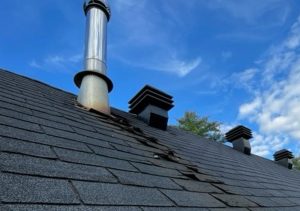Signs of a roof leak may lead to extensive damage, including structural issues, mold growth, and costly repairs. You’ll find below common signs indicating your roof is leaking then provide more explanations for each sign. By recognizing these signs, you can quickly take action to address any roof problems.
The information below are part of the Roof Repair Guide: Homeowner Resources.
Table of Content
4 Signs of a Leaky Roof
1- Water Stains
Water stains on your ceiling or walls are one of the most visible signs of a roof leak. These stains often appear as brown or yellowish discolorations and may expand over time. If you notice water stains, it is a clear indication that water has penetrated your roof and is infiltrating into your home. It is essential to address this issue promptly to prevent further costly damage.
2- Dampness
Another sign of a leaky roof is the presence of dampness in your home. You may notice damp spots on the walls or floors, especially in areas close to the roof. Dampness indicates that moisture is seeping into your home, and if left unattended, it can lead to mold growth and weaken the structural integrity of your property.
3- Mold Growth
Mold thrives in damp environments, making it a common consequence of a leaky roof. If you observe mold growth on your walls, ceilings, or in the attic, it is highly likely that your roof has a leak. Mold not only poses health risks but also indicates a persistent moisture problem that needs immediate attention.
4- Visible Roof Damage
Inspecting your roof for visible signs of damage can help you identify potential leaks. Look for cracked, missing, or damaged shingles, as well as curled or deteriorated roofing materials. These issues can create entry points for water, leading to leaks. Additionally, check for damaged or displaced flashing, plus missing or damages sealant, around chimneys, vents, and skylights, as they are common areas where leaks occur.
Explanations and Roof Problems:
Each sign of a leaky roof can give you insights into the potential problems you might be facing:
– Water stains indicate that water is seeping through your roof and pooling in your home. This could be due to damaged shingles, compromised flashing, or inadequate underlayment. For flat roofs, the location of the leak is usually above the water stain(s). For roof with a slope, the leak is usually higher up on the slope of the roof since water will follow a structure element in the roof along its slop.
– Dampness suggests that moisture is entering your home, which can be caused by roof leaks or poor ventilation. It is crucial to address the issue creating it to prevent further damage and mold growth.
– Mold growth indicates long-term moisture exposure. This can over long term weaken the structure of your home and pose short term health risks. By fixing the roof leaks and addressing moisture-related issues, you can mitigate these problems.
– Visible roof damage, such as cracked shingles or damaged flashing, allows water to infiltrate your home. It is essential to repair or replace these damaged components to prevent leaks and ensure the integrity of your roof.
Identifying the Need for Repair or Replacement
Determining whether your roof requires repair or replacement depends on the severity of the issues:
– Minor leaks or localized damage can often be repaired by replacing damaged shingles, fixing flashing, or sealing small gaps. However, it is crucial to address these issues promptly to prevent further damage.
– Extensive leaks, widespread roof damage, or an aging roof may require replacement. In such cases, consulting a professional roofing contractor is recommended to assess the condition of your roof and provide appropriate recommendations.
How do I know if my roof needs replaced?
You can look at your roof from the inside and outside to estimate if your roof needs to be repaired or replaced.
From inside (if you can go in your attic, see if there’s any signs of):
- – Daylight through the roof boards.
- – Dark stains or streaks.
- – Sagging area.
- – Water leaks (small leak or water damages).
From the outside:
- – Tiles/shingles decay: missing or broken part of the shingles.
- – Moss or beginning stage or vegetation growth: moss can be easily removed but other vegetation growth is a sign of upcoming roth.
- – Decaying shingles: if the tiles or shingles have been moved, cracked or broken see if it’s a generalized issue (whole roof change) or localized, which means you could only need to change the area with the issue.
- – Shingles granules in the gutters: aging shingles will decay and small pieces will crumble down in the gutter due to the sun, wind and wain.
- – Damaged chimney, roof vents or flashing: Flashing is usually easy to change around your chimney just like around roof vents. This can be done without redoing the whole roof if only this area needs repairs.
- – Damages “roof valley”: this is the area where 2 slopes of pitched roofs meet. This often age or get damaged faster due to accumulation of debris, snow and rain flow.
- – Over 20 years roof: a roof reaching 20 years will start to some of the signs above. You’ll need to think about replacing it in the coming seasons or few years.
If you see any of those signs, you should get a free estimate from 1 to 3 local roofing companies.
Being aware of the signs of a leaky roof empowers you to take action and prevent further damage to your home. Remember, timely maintenance and addressing roof issues promptly can save you from costly repairs down the line.
